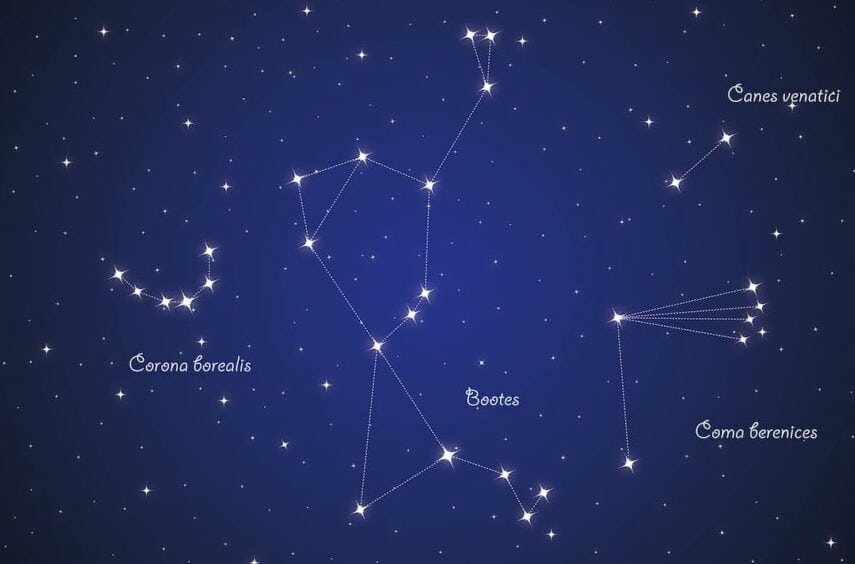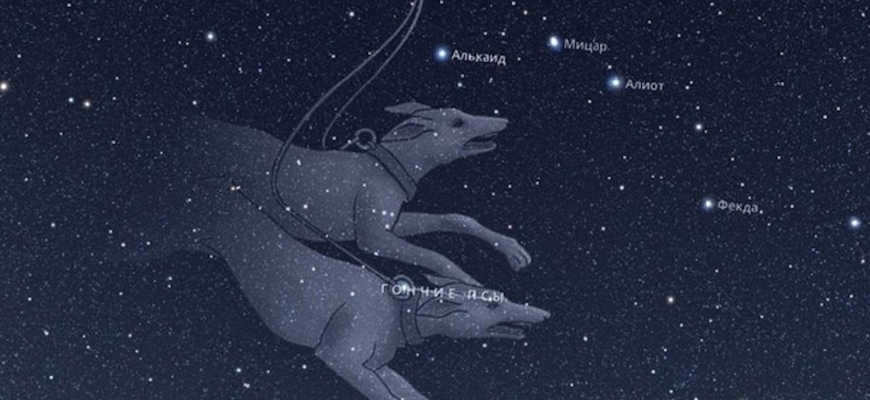
Within the vast expanse of the celestial sphere, where countless stars intricately weave together to form distinct constellations, there emerges one of the most captivating and enigmatic formations – the constellation of the Hound Dogs. This celestial picture captivates our imagination and prompts contemplation regarding its origins, symbolism, and significance.
Taking its rightful place in the nocturnal heavens, the constellation of the Hound Dogs holds an esteemed position and serves as an essential subject of examination for astronomers and stargazers alike. Situated amidst two other stellar constellations, namely the Big Dipper and Hercules, it constitutes a small yet notable fragment of the cosmic panorama.
General information
The constellation Hound Dog is situated in the northern hemisphere of the celestial sphere and covers a total area of 465 square degrees, ranking it as the 38th constellation out of the 88 existing ones. It consists of approximately fifty distinct stars that are visible to the naked eye.
In Latin, this constellation is known as “Canes Venatici”, which can be translated as “Hunting Dogs”. In ancient Greece, it was associated with dogs named Asterion and Chara.
Prior to being recognized as an individual constellation by Jan Hevelius in his atlas, it was not considered as such and its stars were considered part of the Volopassus constellation. Some of these stars, arranged in a beautiful manner, created the depiction of a large club held by Volopas.
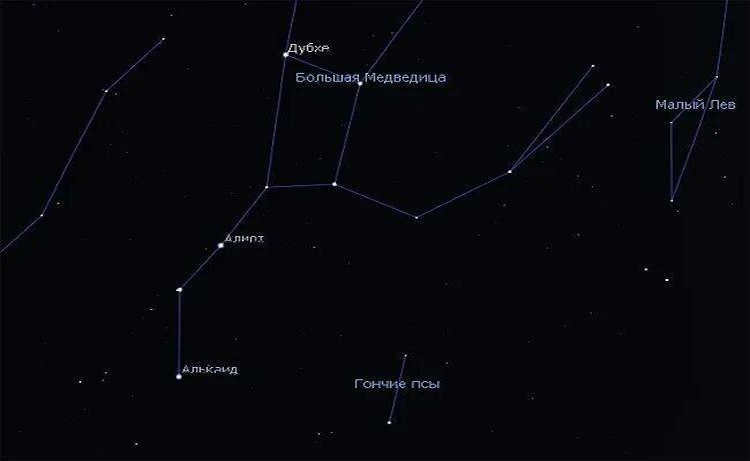
Constellation of the Hound Dogs
The constellation of the Hound Dogs contains several fascinating celestial objects. Here are a few noteworthy ones:
First and foremost, the brightest double system in the Hound Dogs constellation is known as Alpha or the Heart of Charles. It has an average apparent magnitude of 2.9. The system consists of two components: the main sequence star (Alpha-1) and a blue-white hot star (Alpha-2). Interestingly, the second component is actually brighter.
In second place is the star Beta, also known as Hara. Its name translates to “dear” or “joy.” Hara belongs to the yellow-white subgiant class and has a brightness of 4.26. Notably, it is considered a twin of the Sun, as it possesses a similar mass, age, and stage of evolution.
Next in line is Y of the Hound Dogs, which stands out as the most brilliant among the scarce carbon (J-class) and red stars in the constellation. It also happens to be a semi-regular variable star with a magnitude that ranges from 4.8 to 6.3. Within the constellation, it symbolizes supremacy. Scientists hypothesize that this star is currently in the final stages of helium and carbon fusion. As its mass diminishes rapidly, the surrounding disk expands. Eventually, this star will transform into a white dwarf, causing the outer layers to collapse and form a nebula.
The M 3 star cluster (NGC 5272): This particular cluster is a globular one and is home to approximately 500,000 stars. It is one of the most brilliant and expansive clusters of this category within our own Galaxy.
Galaxy M 106 (NGC 4258): Located approximately 21 million light-years away from our position, this peculiar spiral galaxy of Sbp-type showcases a bright nucleus and distinguishes itself through its distinctive structure and vigorous activity.
The pair of galaxies NGC 4490 and NGC 4485: NGC 4490 possesses an apparent stellar magnitude of 10, while NGC 4485 boasts a magnitude of 12.5. The gravitational interaction between these two galaxies results in a warping of their structures.
Galaxy NGC 4449: Utilized as an example by Edwin Hubble in his study of irregular galaxies, this galaxy is classified as irregular and is characterized by intense star formation induced by its interaction with a larger galaxy.
These celestial objects within the Hound Dog constellation hold considerable scientific and astronomical significance, as observing and studying them provides valuable insights into the nature and evolution of galaxies and star clusters.
What is the method to locate in the nighttime sky?
The constellation known as the Canis Major, located adjacent to the Ursa Major, Coma Berenices, and Lupus, is an exceptional constellation.
Even though the Canis Minor constellation lacks bright stars and occupies a small area, it remains easy to locate in a night sky filled with numerous other constellations. All of the stars in the Canis Minor constellation can be found within the “handle” of the Big Dipper. By extending an imaginary line through the stars Dubhe and Fad towards the southeast, you will arrive at the star Kor Karoli, which serves as the primary star of the constellation. Further to the east lies the constellation Boötes with its renowned star Arcturus. The Canis Minor constellation sits relatively high above the horizon and can be clearly seen from any location in Russia.
The Origin
The Hound Dog constellation was initially introduced in the celestial atlas Uranographia, which was published by Jan Hevelius in 1690, making it a brand new constellation. Hevelius portrayed the constellation as two dogs, Asteron and Hara, being attacked by Wolopassus near the Big Dipper. It is important to note that the depiction of dogs in the Volopassus constellation has been used previously. The first known image with this configuration was created by the German cartographer Joannes Stoffler in 1493, and later appeared in Apian’s “Star Chart” in 1540. This image was also used in subsequent works. However, in these images, the configuration was different, the dogs were less prominent, and most importantly, they did not form a separate constellation or have names. Therefore, Jan Hevelius can be credited as the creator of the Hound Dog constellation.
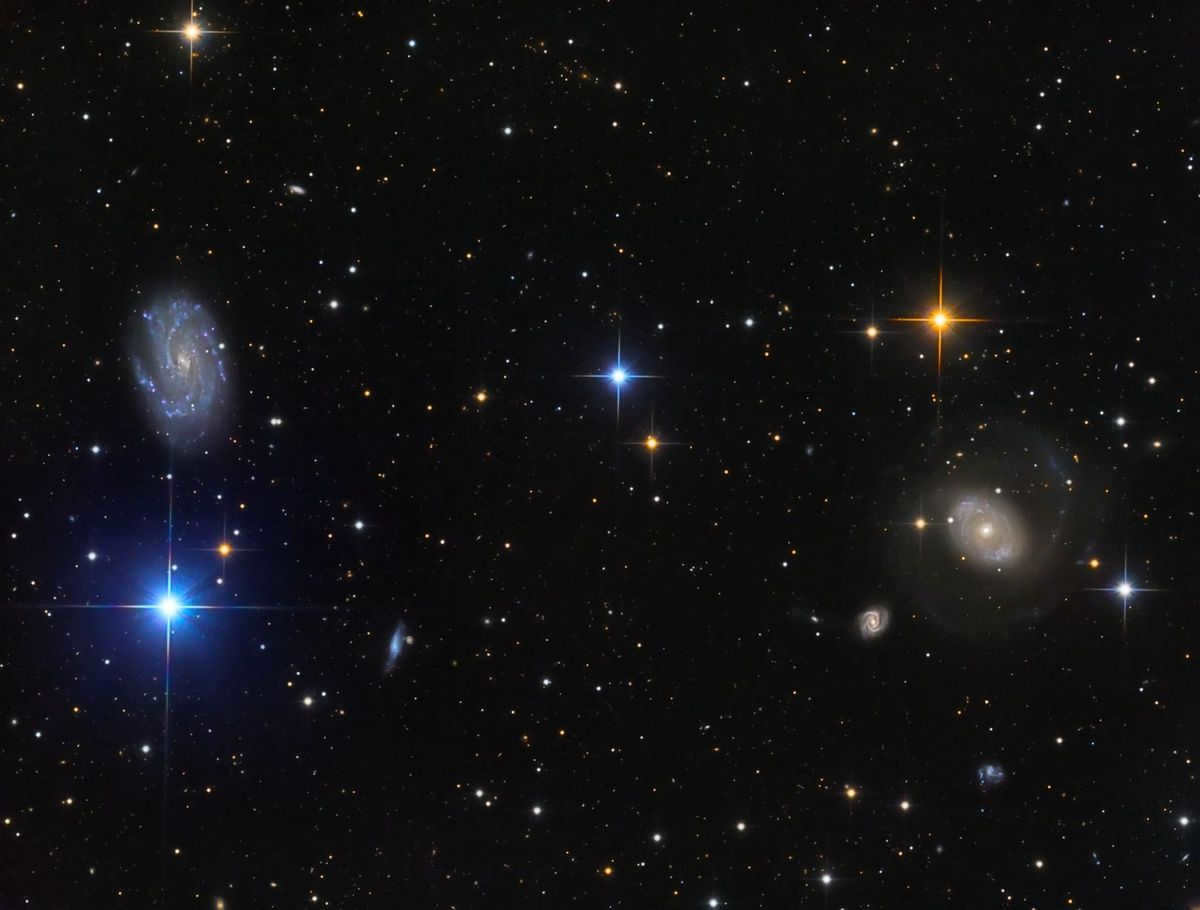
Mythology
The mythological stories surrounding the constellations of the Big Dipper, Little Dipper, Volopassus, and Hound Dogs continue to captivate us with their tragic history.
In ancient times, King Lycaon governed Arcadia and had a daughter named Callisto, renowned for her unparalleled beauty. Her divine charm immediately caught the attention of Zeus, the ruler of both heaven and earth.
Zeus, infatuated with Callisto, visited her in secret at the palace, bypassing his jealous consort Hera. From their clandestine affair, a son named Arcades was born. He grew up to be a slender and skilled hunter, often venturing into the forests in search of game.
When Hera discovered the love affair between Zeus and Callisto, she became furious and transformed Callisto into a hideous bear. One night, after Arcadus returned from a hunting trip, he came across the bear inside their house. Unaware that it was his own mother, he readied his bow to shoot… However, Zeus intervened and prevented Arcadus from committing such a heinous act. In the nick of time, Zeus seized the bear by its tail and swiftly ascended with her into the sky, where he bestowed upon her the form of the constellation known as the Big Dipper. As Zeus carried her across the heavens, the bear’s tail became elongated and curved, shaping it into its distinctive form.
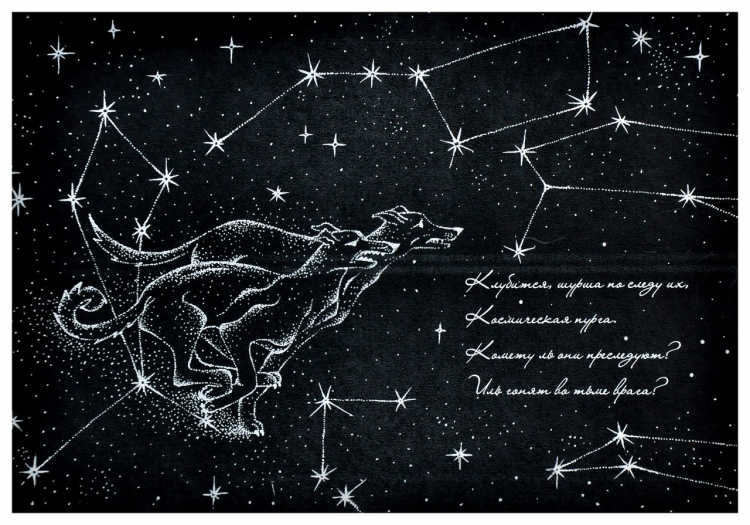
Zeus decided to elevate Callisto and her handmaiden to the sky, transforming them into the constellation known as the Little Bear. Alongside them, Arcadus was also transformed into a small bear cub and joined the constellation.
The constellation of Volopas represents Triptolemus, the first agriculturist. Demeter, the goddess of agriculture, bestowed upon him the tools necessary for farming, and he taught others the art of cultivation. Eventually, he ascended to the heavens with Zeus and became the constellation of Volopassus.
Volopassus is forever tasked with protecting his mother, the Big Dipper. Thus, he tightly holds the leashes of the Hound Dogs, which symbolize fury and are always poised to attack the Big Dipper and tear her apart.
There exists an alternate rendition of this legend. The perpetually youthful goddess Artemis, donned in hunting attire complete with a bow, quiver, and sharp spear, roamed for an extended duration amidst the mountains and forests in pursuit of game. She was accompanied by companions and maids whose laughter and songs filled the peaks of the mountains. Amidst all the beauties, Callisto stood out for possessing unparalleled charm. When Zeus laid eyes upon her, he became captivated by her youthful allure. However, Artemis’ handmaidens were forbidden from marrying. In order to possess Callisto, Zeus concocted a scheme. One night, he appeared before Callisto in the guise of Artemis….
As a result of Zeus’ encounter with Callisto, she gave birth to a son named Arcades, who swiftly matured into an unrivaled hunter.
Hera, the wife of Zeus, became furious and transformed Callisto into a bear after discovering her husband’s unfaithful affair.
One day, while wandering through the woods, Callisto’s son, Arcades, encountered a female bear emerging from the bushes. Unaware that it was his own mother, he instinctively drew his bow and released an arrow in the direction of the bear… However, Zeus, in his concern for Callisto, intervened at the last moment, causing the arrow to veer off course. Simultaneously, Zeus transformed Arcades into a young bear cub. He then seized both the bear and the cub by their tails and lifted them into the sky, where they were immortalized as the constellations Ursa Major and Ursa Minor.
In the heavens, the constellations known as Callisto and Arcade shone with an even greater brilliance than they did on Earth. Their ethereal beauty and ceaseless movement across the celestial expanse were not only admired by mortal beings, but also captivated the attention of Zeus himself. Perched upon his throne on Mount Olympus, he would often gaze upon the majestic constellations of the Big and Little Dipper, reveling in their exquisite splendor.
However, Hera, the queen of the gods, was filled with disgust upon witnessing her husband’s infatuation with these celestial favorites. In her displeasure, she beseeched Poseidon, the mighty god of the seas, to intervene and prevent the Big Dipper from ever touching the waters. She wished for it to wither away, deprived of sustenance! Yet, Poseidon chose not to heed Hera’s pleas. How could he allow the beloved creation of his brother, the mighty thunderer Zeus, to perish from thirst?! Thus, the Big Dipper continues to encircle the celestial pole, descending towards the northern horizon every 24 hours. It gracefully touches the surface of the sea, quenching its thirst, before ascending once more, captivating the gaze of mortals and gods alike with its resplendent beauty.
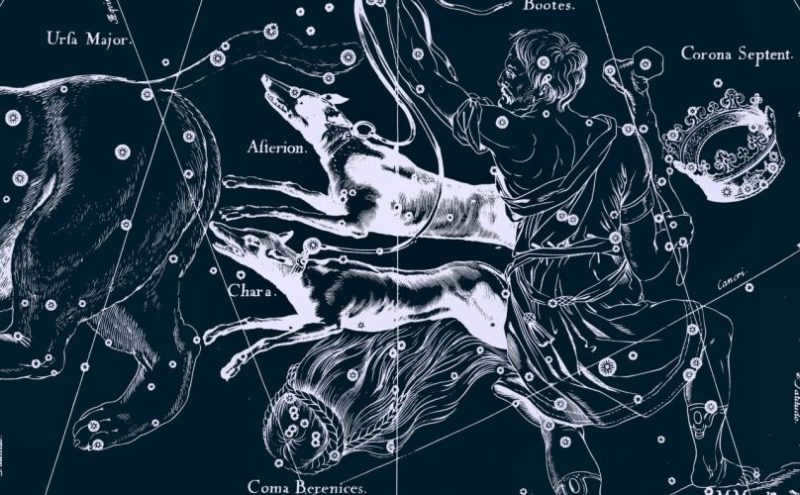
Summary
The Hound Dogs constellation is an extraordinary celestial arrangement with a rich historical background and significant astronomical value. It offers a diverse and captivating experience for enthusiasts of stargazing, making it an excellent subject for observation and appreciation due to its striking appearance and intriguing mythological connections.
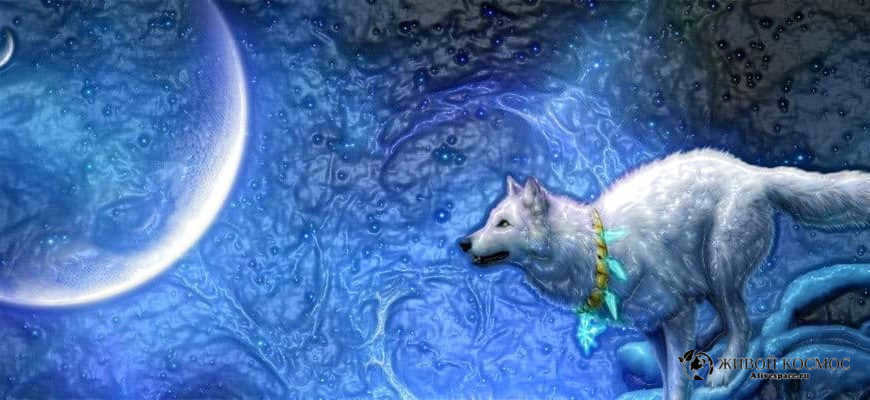
Information about the constellation Hound Dogs is likely known to every citizen in our expansive nation. Its Latin name is Canes venatici. This compact constellation, first discovered in the 17th century by astronomer Jan Hevelius, has been observed by nearly all of us due to its simplicity in locating in the night sky. It is positioned adjacent to the Big Dipper constellation. Within the constellation, there are only two notable stars with significant brightness.
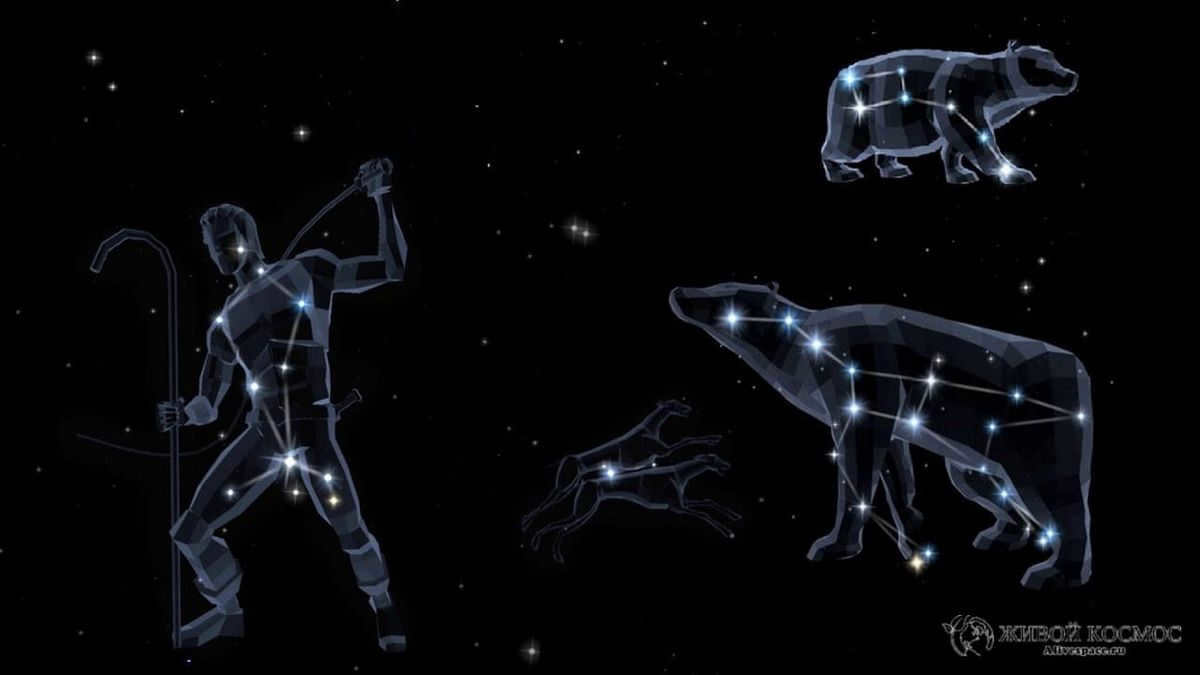
Karl’s Heart. Which one?
One of the primary stars in this group, known as Alpha of the Canes Venatici, received its own designation from Sir Charles Scarborough, an English physicist, mathematician, and astronomer. He named the star “Charles’ Heart” in tribute to King Charles I of England, who was executed by the English politician Oliver Cromwell.
Every respectable constellation or star must have some kind of myth associated with it, right? That’s exactly the case. And that’s why the court physicist from England that we mentioned earlier was absolutely convinced that the star known as “Charles’s Heart” was shining unusually bright on the day the new king arrived in London. It was May 29th, 1660. So, without anyone noticing, our astronomer quickly renamed the star to “Charles II’s Heart” in his atlas by adding two lines at the end of the name. What’s the big deal? The first Charles doesn’t mind, but the second one will be delighted.
And this practical approach paid off. With his own star, Charles II, who always had a smile on his face, personally laid the foundation stone of the Greenwich Royal Observatory. This historic event took place on August 10, 1675.
(That’s all the information you need if you’re seeking funding for your pointless endeavors).
Justly, after several centuries, the celestial body was restored to its initial designation. However, the individuals implicated in the aforementioned incidents were no longer concerned….
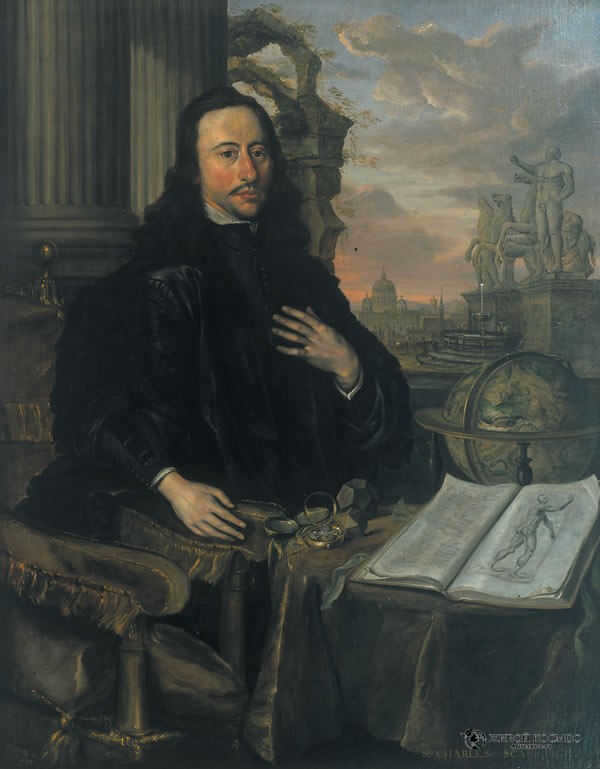
About the constellation Hound Dogs
The Hound Dogs constellation is situated in the Northern Hemisphere and is most easily observed on spring nights. This area of the sky is home to a multitude of galaxies, with one notable example being the Whirlpool Galaxy, also known as M51. The Heart of Charles, a double star system, is located within this constellation and is approximately 110 light-years away. Visible with a small telescope, the main component of this system is a white star that is 80 times brighter than the Sun and has a mass 2.8 times that of our star. The companion star in this system is 1.6 times the mass of the Sun and shines 5 times brighter than our star.
When you have instruments with an aperture larger than 100 mm and a sky that is very dark, you can even observe the spiral structure of the Whirlpool Galaxy. This is because, under these specific conditions, the arms of the galaxy appear quite distinct. The Whirlpool Galaxy, along with its companion NGC 5195, is located approximately 37 million light years away from us.
Astronomers became particularly interested in the Whirlpool Galaxy in 2005 when a Type II supernova was discovered in one of its arms.
Cosmic Sunflowers
Further along the imaginary line we have sketched, in the third section from the Heart of Charles star, we are able to witness another galaxy. It is documented in the Messier catalog as M63, but it is more commonly referred to as the Sunflower Galaxy due to its striking resemblance to this beautiful flower. Upon viewing photographs, one can discern an irregular spiral structure with a texture and luminosity that gradually intensifies from the outer edges and eventually culminates in a clearly discernible central region. M63 belongs to the same cluster of galaxies as M51 and is believed to be situated at a similar distance from our own celestial location.
M106 (NGC 4258) is a spiral galaxy located in the constellation Canes Venatici. It is situated near the border with Ursa Major. This galaxy is approximately 25 million light-years away from our planet and is believed to be a massive spiral galaxy similar in size to the Andromeda galaxy. X-ray studies have provided evidence supporting the theory that M106 is a Seyfert-type galaxy and that it contains a massive black hole at its core.
+ Astroplot: 53°20’56.505″ N 83°46’07.735″ E, Habs. = 209 m.

The constellation Canes Venatici (CVn).
Situated to the south and west of Ursa Major and to the east of Boötes, Canes Venatici covers an area of 465.2 square degrees in the night sky and contains 57 stars that can be seen without the aid of a telescope. The name of the constellation was given by Jan Hevelius during the 17th century.
In 1725, Edmond Halley named the brightest star in Canes Venatici Alpha Canum Venaticorum, which translates to the Heart of the Hunting Dogs, in honor of King Charles II of England. Alpha Canum Venaticorum is a stunning double star system, with one of its components emitting a yellow light and the other a violet light. Another fascinating object within the constellation is the spiral galaxy M51, which can be observed using a good pair of binoculars and is located approximately 3 degrees southwest of the last star in the tail of Ursa Major. This galaxy has a visual magnitude of 9 and is situated 23 million light years away from Earth. Additionally, a companion galaxy can be seen at the end of one of M51’s spiral arms.
The Latin name of the constellation Canes Venatici is Hound Dogs.
Representation of Hound Dogs in the atlas of Jan Hevelius:
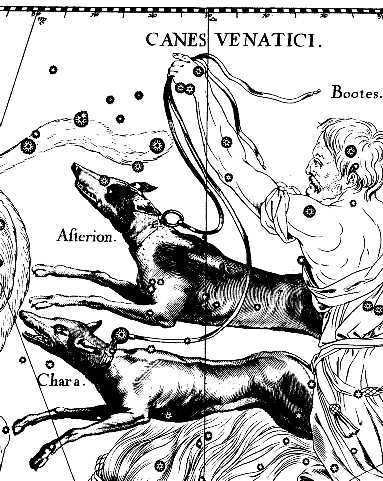

Canine Constellations:
Data source: Astronet
Date of publication: Monday, November 18, 2002
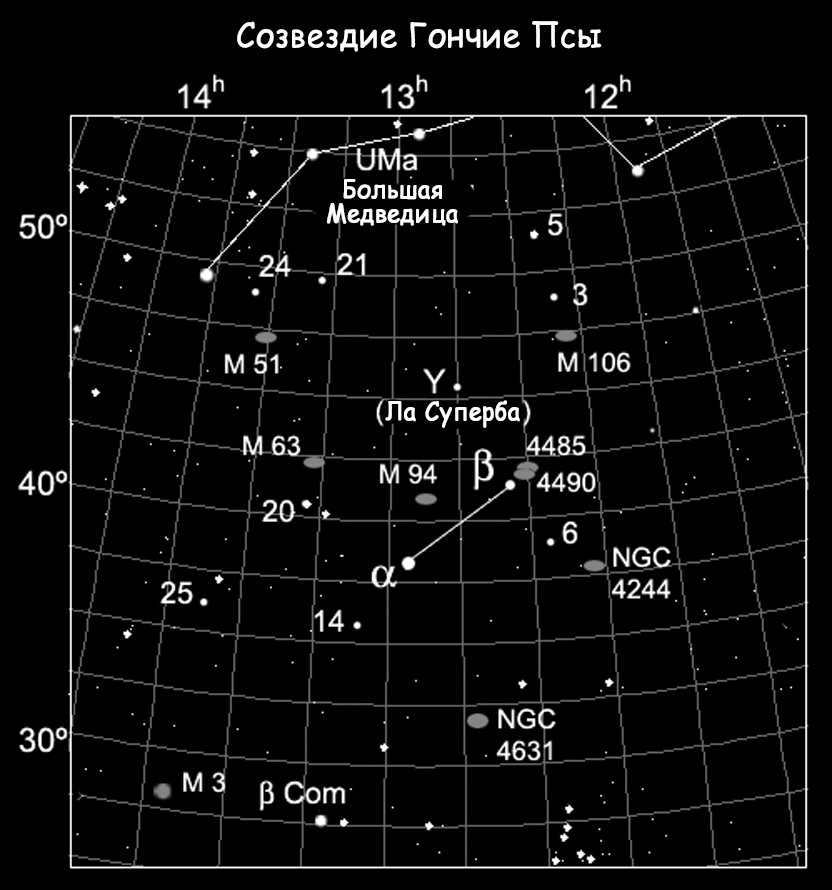
In the northern hemisphere lies the constellation known as the Hound Dogs, and it was first observed by the Polish astronomer Johannes Hevelius in the 17th century.
What is the best way to observe the Hound Dog star formation in the night sky?
Situated in close proximity to constellations like the Big Dipper, Veronica’s Hair, and Volopassus, the Hound Dog star formation is a captivating sight. In Russia, it can be seen during the early spring months of March and April.
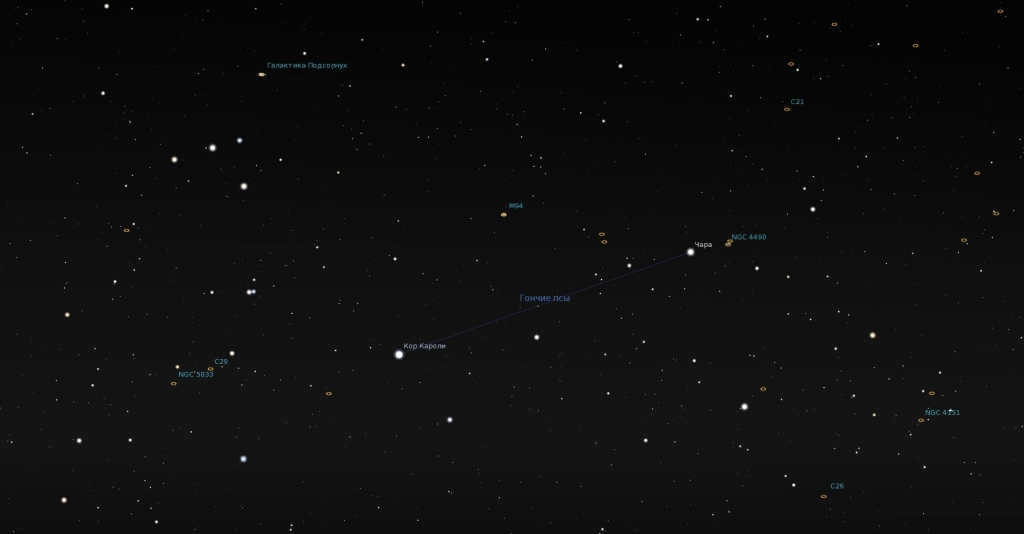
The position of the constellation Hound Dogs can be observed using a planetarium program.
The constellation of the Canes Venatici is not known for its particularly bright stars and has a relatively small area, but this does not hinder its visibility in the expansive sky, adorned with numerous constellations. The entirety of the star formation of the Canes Venatici fits neatly within the “handle” of Ursa Major, which hangs like a cloud above the Auriga. By using your finger as a “celestial marker” and tracing a line from the star Dubhe (the alpha star of Ursa Major) to the star Fad (the gamma star of Ursa Major) in a southeastern direction, this trajectory will lead you to the magnificent star Cor Caroli, which serves as the alpha star of the Canes Venatici constellation. To the east of it lies the star formation of the Canis Major and its well-known star, Arcturus. The Canes Venatici constellation sits high above the horizon and is easily observable across the expansive Russian landscape. The optimal weather conditions for high-quality visual observation are typically found in the months of March and April.
The most fascinating aspects of star formation in the Hound Dogs
The initial star with the highest brightness
Considered as the most radiant star within this star formation, Cor Caroli or Alpha Hound Dogs shines with a brightness of 2.81. This star is unique as it consists of two binary stars and is situated approximately 110 light years away from our planet. The second component, known as alpha Canum Venaticorum, possesses a magnetic field that is five thousand times stronger than Earth’s, and it also exhibits an overabundance of chemical elements such as Silicon (Si), Europium (Eu), and Mercury (Hg). Out of the two partners, alpha Canum Venaticorum boasts the highest luminosity. The star received its name, Cor Caroli Regis Martyris, in honor of the renowned English mathematician Charles Scarborough and Dr. Charles 2.
The second brightest star in the constellation
Occupying the second position in terms of brightness in the constellation is a star known as Chara, which is the beta star of Canes Venatici. Chara belongs to the G-type dwarf category and shares similarities with our own Sun. It is part of the constellation Canes Venatici, along with Cor Caroli. Originally, the name Chara referred to the “Southern Dog,” but it later became exclusively associated with the beta star of Canes Venatici. Astrobiologists have recognized Chara as one of the most remarkable objects in the night sky, and in 2006, renowned astronomer Margaret Turnbull declared it to be an ideal candidate for the search for extraterrestrial civilizations.
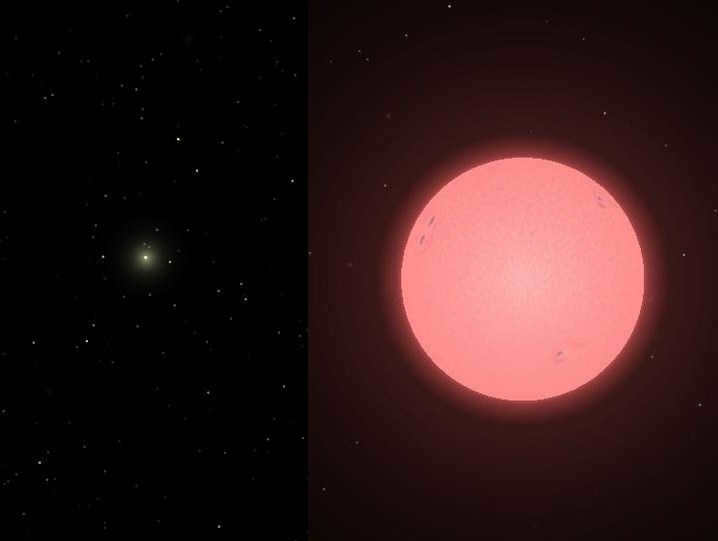
The Hound Dogs’ Y is visible from a distance of 25 astronomical units in the Celestia program.
An intriguing feature of this star formation is La Superba, also known as the gamma star in the constellation Hound Dogs. La Superba falls into the category of semi-regular variable stars and is particularly notable for its distinctive and vibrant red glow. It stands out as one of the brightest carbon giants and the brightest star of the J-type in the nighttime sky (J-group stars are characterized by a high carbon-13 content). With a temperature of 2800 K, La Superba is recognized as one of the coldest stars known to mankind. Surrounding the star is a nebula composed of depleted material spanning a width of two and a half light-years. Angelo Secchi, an astronomer of Italian origin, first discovered La Superba in the early nineteenth century.
The remaining celestial bodies in the Hound Dog constellation consist of
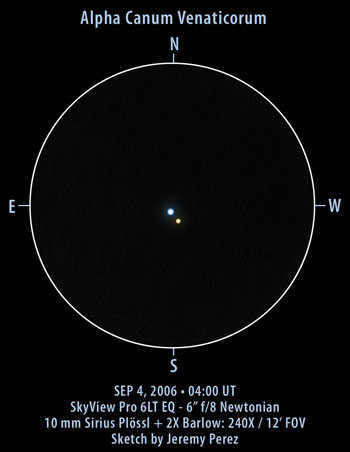
Canum Venaticorum, an image taken by an amateur
There are two additional fascinating stars within this star formation, namely AM Canum Venaticorum and 20 Canum Venaticorum. The former is a massive blue star and is categorized as a cataclysmic variable star. This implies that its brightness fluctuates irregularly, increasing multiple times and then declining sharply.
The latter star is classified as a yellow-white giant of the F-class and is situated at a distance of two hundred and eighty-six light years from our planet. It is also considered a variable star.
M3 or NGC 5272: The spherical cluster of stars
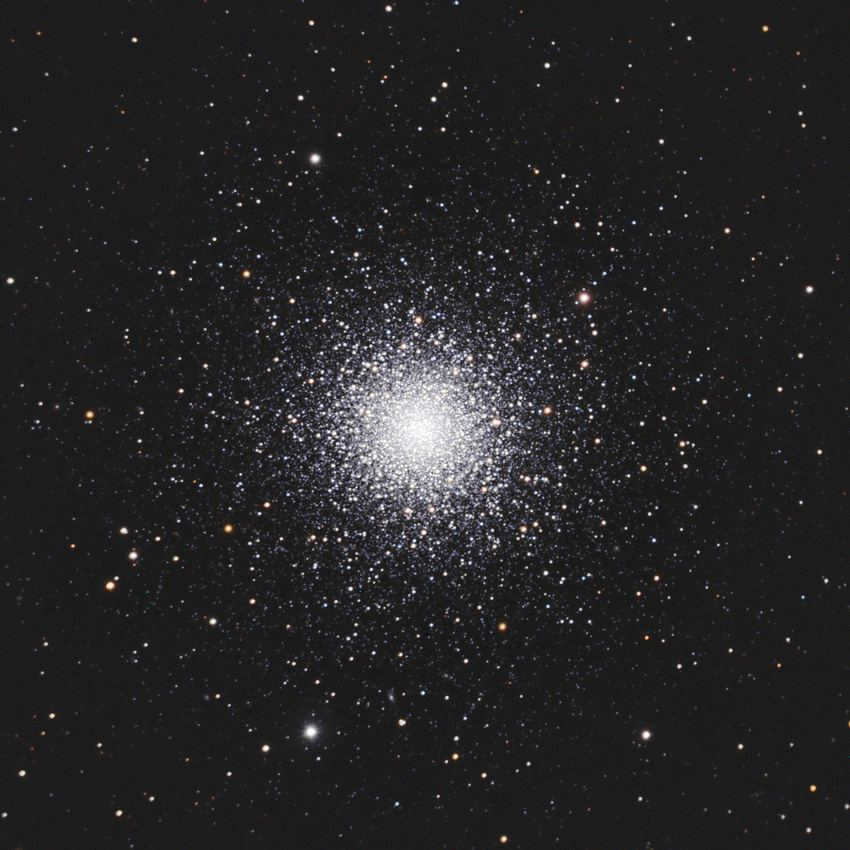
Amateur Image of NGC 5272
The constellation known as The Hound Dog is well-known for its celestial objects, including the impressive globular cluster M3, also referred to as NGC 5272. This immense cluster is recognized as one of the brightest in its classification and is surrounded by neighboring star formations called Volopassus and Veronica’s Hair.
The M63 Galaxy
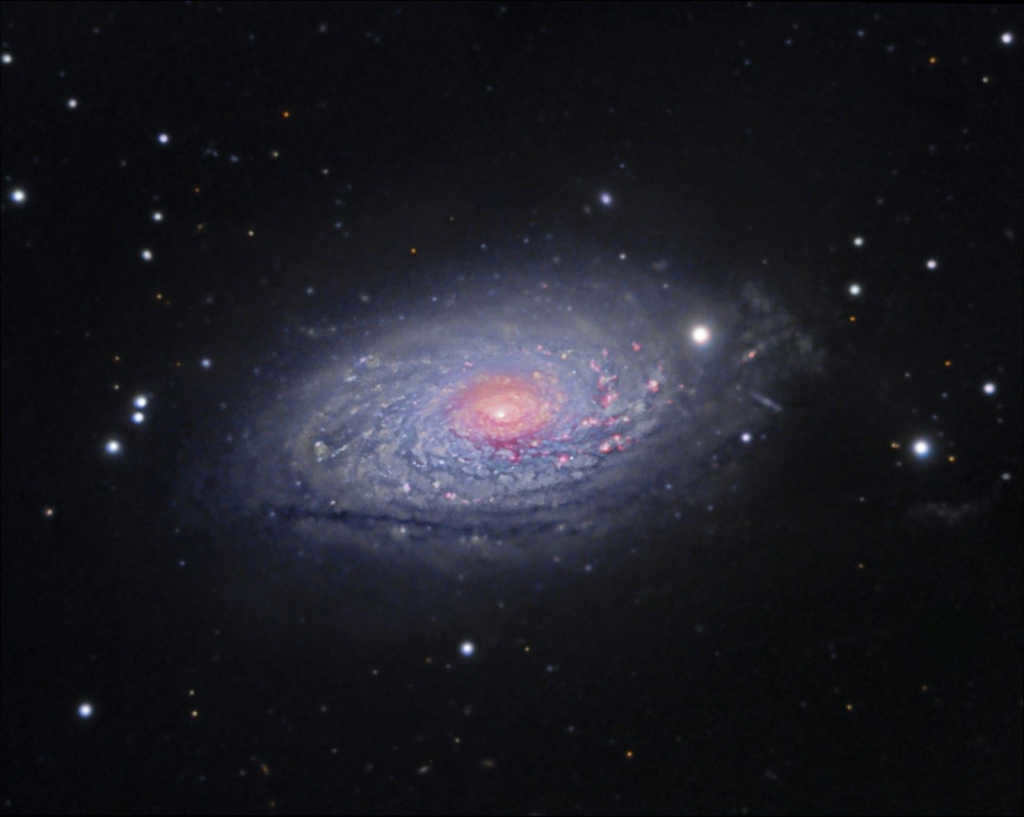
M63, also known as NGC 5055, is a remarkable galaxy resembling a sunflower.
The Sunflower Galaxy, also known as the spiral galaxy M63, is an incredibly luminous and elongated galaxy with a highly dense central region. It is positioned between M51 and Cor Caroli.
The galaxy M49, also referred to as the SAB galaxy, and undoubtedly M101, a galaxy with the most brilliant luminosity, are both categorized as spiral galaxies and are situated in close proximity to the beta star of the Hound Dog constellation.
The famous Whirlpool galaxy, or M51, is another example of two spiral galaxies located in this constellation.
A brief history
In the past, there was a depiction of two dogs with their heads facing the Big Dipper. This created the illusion that Volopas was urging his dogs towards the Big Dipper. Interestingly, in the year 1493, an astronomer and cartographer from Germany included a similar image in his star atlas, but in his version, the dogs were associated with the star formation known as Volopassus.


